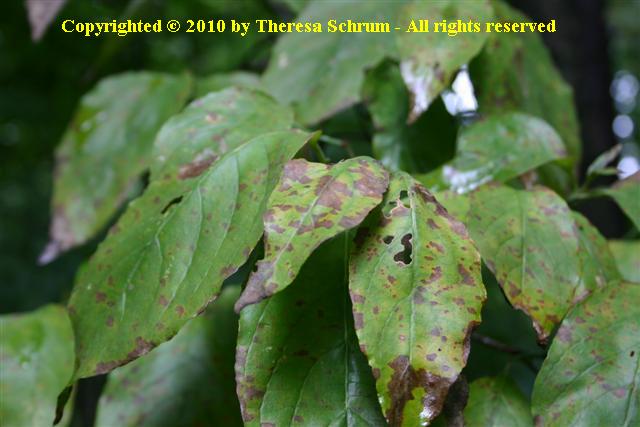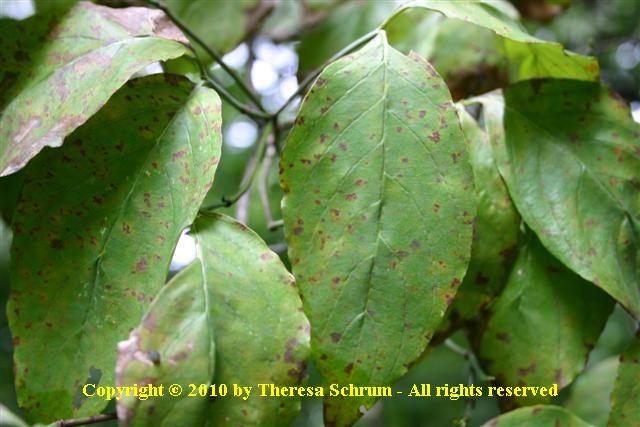Georgia Gardener Newsletter
Ask An Arborist: April 11, 2013

|

|
| Spot Anthracnose |
Septoria Leaf Spot |
Every time we have a wet spring:
Every year the dogwoods in my woods end up with spots on the leaves. Now, the spots are also showing up on the flowers. What is it and how can I get rid of it?
I posed this question to Art Morris, Board Certified Master Arborist with Bartlett Tree Experts. His response was:
"Flowering dogwood is one of the most recognizable ornamental trees in
the Georgia landscape; unfortunately, it's also susceptble to a number
of foliar diseases, most notably Dogwood (Spot) Anthracnose and Powdery Mildew.
Anthracnose typically affects dogwoods during wet spring weather. It
causes irregular brown blotches on the leaves, expecially around the
edges. Powdery Mildew is most prevalent in the summer, it begins as a
white haze and eventually casues brown spots on leaves. Powdery Mildew
can also cause stunting of leaf growth and dieback of branches.
Treatment for these diseases typically consists of a series of foliar
fungicide applications. There are several cultural practices that may
also help improve tree health and reduce the risk of disease damage:
1. Mulch trees correctly with a 2-4 inch thick layer of mulch from near
the trunk to the drip line.
2. Water trees with 1 inch of water in the absence of adequate rainfall.
3. Avoid overhead irrigation that sprays the leaves of the dogwood.
4. Test soil and fertilize as needed to maintain adequate nutrient
levels."
All of the diseases to which Art was referring to above are fungal diseases. There are two varieties of anthracnose that
often resemble each other. Spot anthracnose is caused by the fungus Elsinoe corni. It causes the nearly round
spots on leaves and occasionally the flowers, fruit and young twigs. The spots have a purple-brownish exterior and a
lighter colored center. Repeated
severe infections can weaken trees. The second anthracnose known as discula anthracnose is caused by the fungus
Discula destructiva and as the name implies, is very destructive. The spots are irregular in shape with a purple-brownish
color and eventually blend together to cause the leaf to turn brown. The disease can spread to the flowers, branches and trunk
where it will cause cankers. Advanced infections often lead to tree death. Discula anthracnose has decimated a significant
portion of the dogwoods in the Appalachians and into northern Georgia. It may be advisable to remove and destroy trees infected
with discula anthracnose once it has been diagnosed. Both anthracnose diseases appear in the early spring sometimes
before the flowers have bloomed.
Septoria leaf spot is caused by the fungus Septoria cornicola and appears in the late summer as tiny round spots over the
leaves. Since this disease appears when the leaves will soon drop, I don't usually use any fungicides for control.
The other late-season spot disease, as Art mentioned above, is powdery mildew which is caused mostly by the fungus
Microsphaeria pulchra. Powdery mildew on dogwoods resembles powdery mildew on roses and crape myrtles, although the
offending pathogens are different. Leaves take on a gray, powdered look that can be scraped off with a fingernail. Leaves may
become twisted or distored as the infection advances.
Chemical treatment for all these diseases usually has to take place prior to the appearance of symptoms. Therefore, if you have
a dogwood that has a history of these problems, begin treatment early. Rake out the leaves of infected dogwoods as soon as they
drop and place them in plastic bags in the trash. Do not use them as mulch. Replace the leaves with another mulch such as
pine straw or shredded pine/hardwood bark.
The Virginia Cooperative Extension has an excellent article entitled
"Foliar Diseases of Dogwoods." They have lists of
recommended fungicides as well as resistant varieties of dogwoods that you can plant in your yard.
Please email me if you have any questions or topics you would like to submit
for later articles.
If you are concerned about the trees in your landscape, you can contact
the Georgia Arborist Association.
Unless otherwise noted, Images & Drawings Copyrighted © 2013 by Theresa Schrum - All rights reserved



